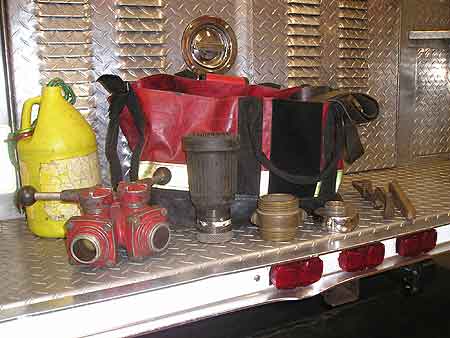Article and photos by David DeStefano
When companies arrive at an incident where smoke or fire is showing, there is little doubt that members of the first-in engine and truck will take appropriate tools and hose from the rigs with which to begin firefighting operations. However, when investigating so called “nothing showing” or “smells and bells” calls, members must consider that tools and hose may still be needed for a fire condition that is not apparent from the street.
The best way to be prepared while investigating an incident with “nothing showing” is to preassign tools/equipment for each company member based on the incident type and occupancy. When investigating small, single-occupancy dwellings or commercial buildings within the reach of a preconnect, the engine company may not bring in a line until needed; however, both engine and truck companies should carry basic tools each time they leave the rig to make an investigation.
Based on the premise that companies are investigating an occupancy in which all points are within reach of a preconnect, the following can be used as a guide that the first-in engine company may employ while investigating:
All members shall be equipped with full personal protective equipment (PPE), self-contained breathing apparatus (SCBA), hand lights, and radios.
· Company Officer: small forcible entry tool (O-tool, mini-halligan, etc.), thermal imaging camera (TIC), access keys.
· Firefighter 1: Pressurized water extinguisher (or other type extinguisher based on nature of incident).
· Firefighter 2: Halligan and flathead ax.
At incidents where engine company members must investigate an occupancy in which points are beyond the reach of a preconnect, the engine officer must have a plan to quickly and efficiently deploy a line to any point in the structure. This may include stretching from a standpipe in some occupancies, stretching over a ladder, or employing a rope bag or jug for an outside stretch. In the case of standpipe operations, the engine company must be prepared to stretch enough hose to operate an effective stream to any point on the fire floor based on department policy for hose diameter and point of connection.
During an investigation in an occupancy that has stretches beyond the reach of preconnects, but is not equipped with standpipe connections, the engine company may choose to include 100 feet or more of 1¾-inch attack line. This line may be stretched to the fire while additional hose is hauled by rope from a window, balcony, or fire escape to complete the stretch. The engine company chauffeur or another company may supply the outside stretch with a 3-inch line and gated wye or an additional 1¾-inch hose to complete the stretch from the outside.
During the investigative mode at buildings such as these, many engine companies find it beneficial to treat them as standpipe-equipped occupancies as far as the cadre of equipment they work with. This selection may include the following:
All members shall be equipped with full PPE, SCBA, hand lights and radios.
· Company officer: Small forcible entry tool (O-tool, mini-halligan, etc.), TIC, access keys, appliance bag (includes rope jug).
· Firefighter 1: Hose bundle.
· Firefighter 2: Hose bundle and/or water extinguisher.
It is important to note that engine company members must be supported by adequate truck company operations to operate effectively. This includes truck company firefighters providing forcible entry and searching for victims as well as the seat of the fire while the engine company makes its stretch.
To provide proper access, search, and ventilation as appropriate, ladder company members must be prepared with the necessary tools based on the occupancy construction and type. These tools may vary slightly based on the prevalent construction and security measures in a particular area. A basic tool assignment list may include:
All members shall be equipped with full PPE, SCBA, hand lights, and radios.
· Company officer: TIC, access keys, halligan tool, appropriate length hook.
· Firefighter 1: Hook, pressurized water extinguisher, halligan tool.
· Firefighter 2: Halligan tool, flathead or maul ax, hydra-ram or rabbit tool with through-the lock-kit in the same bag.
These basic tools will serve most purposes for the interior firefighters of the first-in truck company. Investigating with these tools will enable members to begin their search and forcible entry functions without delay and can make all the difference in locating the seat of a fire while it is still manageable or in effecting the rescue of a severely endangered occupant.
Local needs dictate tool preference, and available personnel will determine the tasks assigned to each company. But preassigned tools and equipment for responses to typical occupancies in the district will ensure that members don’t enter a building empty handed. Prior knowledge of what tools to carry and the function they serve will relieve some of the burden on the company officer to issue orders. The officer will always know the immediate capabilities of his company if they find a fire during their investigation. This will increase the safety and efficiency of the initial units and help set a smooth path for the incident.


(1-2) When investigating locations in a building beyond the reach of pre-connects engine company members should equip themselves with adequate hose and appliances for a standpipe or outside stretch.

(3) Truck companies should pre-assign forcible entry tools for the prevalent occupancy types in their district. Tools for conventional and through-the-lock forcible entry should be readily available for use by the forcible entry team.
David DeStefano is a 22-year veteran of the North Providence (RI) Fire Department, where he serves as a lieutenant in Ladder Co. 1. He previously served as a lieutenant in Engine 3 and was a firefighter in Ladder 1. He teaches a variety of topics for the Rhode Island Fire Academy. He can be reached at dmd2334@cox.net.

